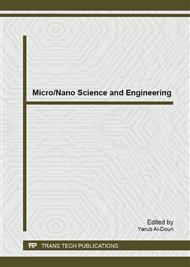p.3
p.8
p.13
p.18
p.23
p.28
p.33
p.38
p.43
Synthesis of MCM-41 from Rice Husk Ash and its Utilization for Lipase Immobilization
Abstract:
Mesoporous materials are favorable for enzyme immobilization due to their unique properties of large surface area, uniform pore system and functionalizable surfaces. Immobilization on these materials enhances enzyme stability, activity and resistance towards harsh environmental conditions such as temperature and pH. The present study deals with synthesis of mesoporous materials namely MCM-41. For that purpose, the MCM-41 was synthesized using cetyltrimethylammonium bromide (CTAB) as a template and extractable silica from rice husk ash as a silica source. The synthesis was performed under alkaline conditions to produce white fine solid particles, followed by grafting with 3-aminopropyltriethoxysilane and activation with carbodiimide before it was immobilized with lipase. Characterization of those fine particles using Nitrogen physisorption gives BET surface area, as BET, and the pore diameterto be 1184 m²/g and 2.58 nm respectively. Fourier Transform Infrared spectra show peak of SiO2, NH2 and COOH functional group which confirms the existence of those compounds in covalent bonding formation between amine-grafted MCM-41 and lipase enzyme. Immobilized enzyme shows an increase in pH stability when compared to free enzyme at fixed temperature of 20°C in time range from 30 to 180 minutes.
Info:
Periodical:
Pages:
23-27
Citation:
Online since:
April 2014
Keywords:
Price:
Сopyright:
© 2014 Trans Tech Publications Ltd. All Rights Reserved
Share:
Citation:


